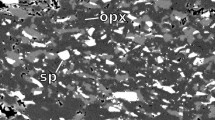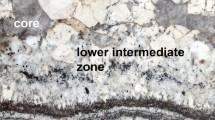Abstract
The Irvine olivine-spinel geothermometer, as formulated by Jackson (1969), appears to yield magmatic temperatures when applied to plutonic rocks such as the Stillwater Complex but Evans and Wright (1972) have demonstrated that it gives temperatures in excess of 2,000 ° C when applied to volcanic assemblages. A re-evaluation of the geothermometer has shown that more realistic temperatures can be obtained for volcanic rocks by using a different free energy value of FeCr2O4 in the formulation. The revised geothermometer gives temperatures in the range 1,100–1,300 ° C for samples from Kilauea and 500–800 ° C for basic plutonic rocks from layered intrusions, indicating that Mg and Fe2+ have re-equilibrated at subsolidus temperatures in these intrusions as suggested by Irvine (1965). This theory was tested by heating uncrushed natural samples from layered intrusions to magmatic temperatures for periods ranging from two days to four weeks. The result was a marked increase in the Mg/Fe2+ ratio in the spinels and a decrease in the Mg/Fe2+ ratio in the olivines, confirming that considerable subsolidus re-equilibration had taken place in the unheated samples.
Similar content being viewed by others
References
Arndt, N.T., Naldrett, A.J., Pyke, D.R.: Komatiitic and iron-rich tholeiitic lavas of Munro township, northeastern Ontario. J. Petrol. 18, 319–69 (1977) [30]
Basu, A., MacGregor, I.D.: Chromite spinels from ultramafic xenoliths. Geochim. Cosmochim. Acta 39, 937–45 (1975) [29]
Bunch, T.E., Keil, K., Oslen, E.: Mineralogy and petrology of silicate inclusions in iron meteorites. Contrib. Mineral. Petrol. 25, 297–340 (1970) [28]
Campbell, I.H.: A study of macro-rhythmic layering and cumulate processes in the Jimberlana Intrusion, Western Australia. Part I: Upper layered series. J. Petrol. 18, 183–214 (1977)
Chan, J.C., Alcock, C.B., Jacob, K.T.: Electrochemical measurement of the oxygen potential of the system Fe-Al2O3-FeAl2O4 in the temperature range 750–1,600 ° C. Can. Met. Quart. 12, 439–43 (1973)
Evans, B.W., Frost, B.R.: Chrome-spinel in progressive metamor-phism — a preliminary analysis. Geochim. Cosmochim. Acta 39, 959–72 (1975)
Evans, B.W., Wright, T.L.: Composition of liquidus chromite from the 1959 (Kilauea Iki) and 1965 (Makaopuhii) eruptions of the Kilauea volcano. Am. Mineral. 57, 217–30 (1972) [1]
Fudali, R.F., Noonan, A.F.: Gobabeg, a new chondrite: the coexistence of equilibrated silicates and unequilibrated spinels. Meteoritics 1, 31–39 (1975) [27]
Fujii, T.: Fe-Mg partitioning between olivine and spinel. Carnegie Inst. Geophys. Lab. Rep. 1976–1977, 563–9 (1978)
Green, D.H.: The petrogenesis of the high-temperature peridotite intrusion in the Lizard area, Cornwall. J. Petrol. 5, 134–88 (1964) [25]
Hill, R.E.T., Roeder, P.L.: The crystallisation of spinel from basaltic liquid as a function of oxygen pressure. J. Geol. 82, 709–29 (1974)
Himmelberg, G., Loney, R.A.: Vulcan peak alpine-type harzburgite, Southwestern Oregon. Geol. Soc. Am. Bull. 84, 1585–1600 (1973) [24]
Irvine, T.N.: Chromian spinel as a petrogenetic indicator. I. Theory. Can. J. Earth Sci. 2, 648–72 (1965)
Irvine, T.N.: Chromian spinel as a petrogenetic indicator. II. Petrologic application. Can. J. Earth. Sci. 4, 71–103 (1967)
Jackson, E.D.: Chemical variation in coexisting chromite and olivine in the chromitite zones of the Stillwater complex. Econ. Geol. Mon. 4, 41–71 (1969) [3]
Jacob, K.T., Alcock, C.B.: The oxygen potential of the systems Fe+FeCr2O4+Cr2O3 and Fe+FeV2O4+V2O3 in the temperature range 750–1,600 ° C. Metal. Trans. 6B, 215–9 (1975) [16]
Janaf thermodynamic tables, Second edition, C.R. Stull and H. Prophet, eds. Nat. Stand. Ref. Data Ser. 37, 1141 (1971) [17]
King, E.G., Barany, R., Weller, W.W., Pankratz, L.B.: Thermodynamic properties of forsterite and serpentine. U.S. Bur. Mines Rept. Inv. 6962, 19 (1967)
McLean, A., Ward, R.G.: Thermodynamics of hercynite formation. J. Iron Steel Inc. 204, 8–13 (1966) [20]
Medaris, L.G.: High-pressure peridotites in southwestern Oregon. Geol. Soc. Am. Bull. 83, 41–58 (1972) [5]
Medaris, L.G.: Coexisting spinels and silicates in alpine peridotites of the granulite facies. Geochim. Cosmochim. Acta 39, 947–58 (1975) [26]
Muller, F., Kleppa, O.J.: Thermodynamics of formation of chromite spinels. J. Inorg. Nucl. Chem. 35, 2673–8 (1973) [13]
Nafziger, R.H., Muan, A.: Equilibrium phase compositions and thermodynamic properties of olivines and pyroxenes in the system MgO-“FeO”-SiO2. Am. Mineral. 52, 1364–86 (1967)
Novokhatskii, I.A., Lenev, L.M.: Thermodynamic properties of Cr2O3 and FeCr2O4 at high temperatures. Russ. J. Inorg. Chem. 11, 1078–81 (1966) [14]
O'Hara, M.J.: Mineral facies in ultrabasic rocks. In: Ultramafic and related rocks (P.J. Wyllie, ed.), pp. 7–17. New York: John Wiley 1967
Potter, E.A.: Silicate liquid inclusions in olivine crystals from Kilauea, Hawaii. Unpublished M.Sc. thesis, Queen's University (1975)
Rezukhina, T.N., Levitskii, V.A., Istomin, B.A.: Thermodynamic properties of FeCr2O4 from electrochemical measurements. Sov. Electrochem. 1, 404–7 (1965) [15]
Rezukhina, T.N., Levitskii, V.A., Pozhegov, P.: Thermodynamic properties of iron aluminate. Russ. J. Phys. Chem. 37, 358–9 (1963) [21]
Robie, R.A., Waldbaum, D.R.: Thermodynamic properties of minerals and related substances. U.S. Geol. Surv. Bull. 1259, pp. 256 (1968) [18]
Schwerdtfeger, K., Muan, A.: Activities in olivine and pyroxenoid solid solutions of the system Fe-Mn-Si-O at 1,150 ° C. Trans. Metall. Soc. A.I.M.E. 236, 201–11 (1966)
Shearer, J.A., Kleppa, O.J.: The enthalpies of MgAl2O4, MgSiO3, Mg2SiO4 and Al2SiO5 by oxide melt calorimetry. J. Inorg. Nucl. Chem. 35, 1073–7 (1973) [17]
Sinton, J.M.: Equilibration history of the basal alpine-type peridotite, Red Mountain, New Zealand. J. Petrol. 18, 216–46 (1977) [4]
Speidel, D.H., Osborn, E.F.: Element distribution among coexisting phases in the system MgO-FeO-Fe2O3-SiO2 as a function of temperature and oxygen fugacity. Am. Mineral. 52, 1139–53 (1967)
Tretjakow, J.D. Von, Schmalzried, H.: Zur Thermodynamik von Spinellphasen. Ber. Bunsenges. Phys. Chem. 69, 396–402 (1965) [12]
Wood, B.J., Fraser, D.G.: Elementary thermodynamics for geologists. 303 p. London: Oxford Press 1976
Wood, B.J., Nicholls, J.: The thermodynamic properties of reciprocal solid solutions. Contrib. Mineral. Petrol. 66, 389–400 (1978)
Author information
Authors and Affiliations
Rights and permissions
About this article
Cite this article
Roeder, P.L., Campbell, I.H. & Jamieson, H.E. A re-evaluation of the olivine-spinel geothermometer. Contr. Mineral. and Petrol. 68, 325–334 (1979). https://doi.org/10.1007/BF00371554
Accepted:
Issue Date:
DOI: https://doi.org/10.1007/BF00371554




